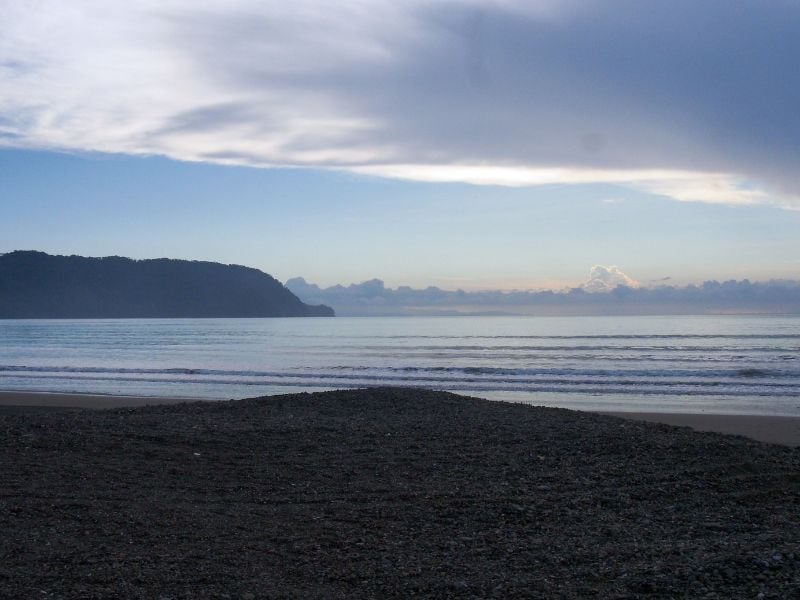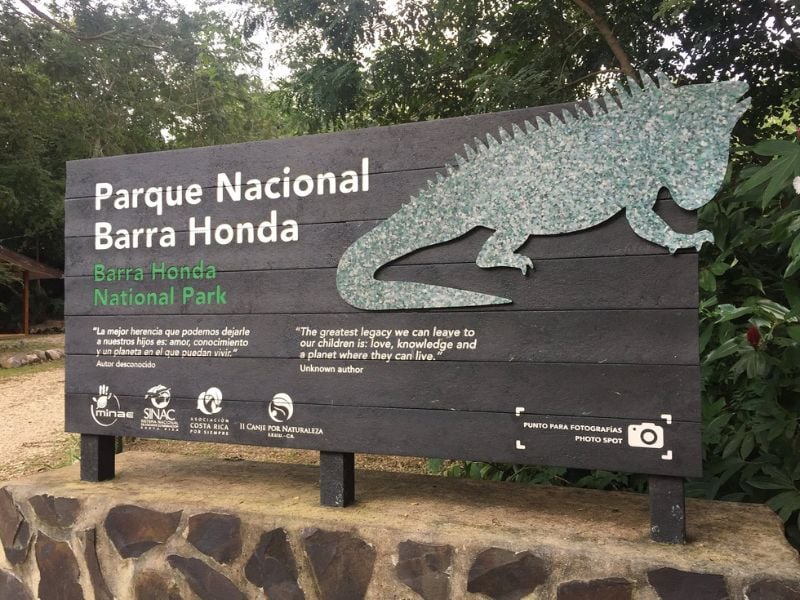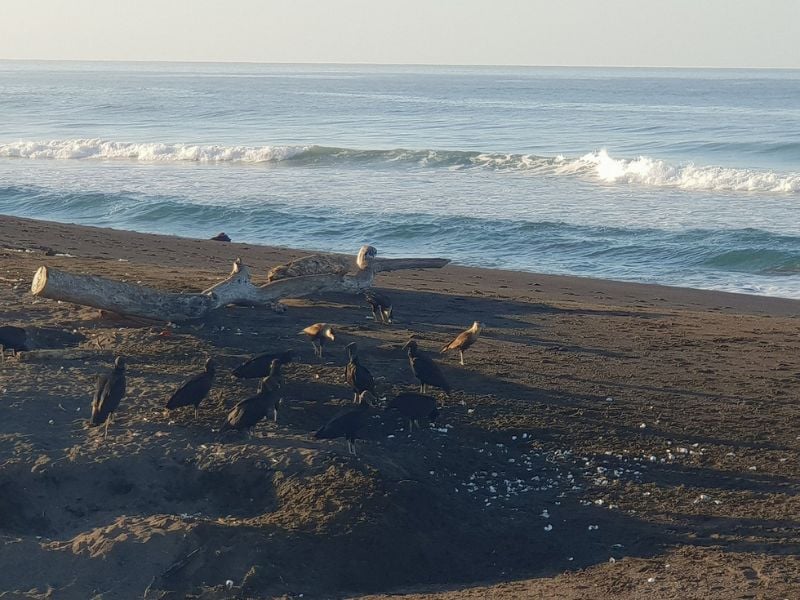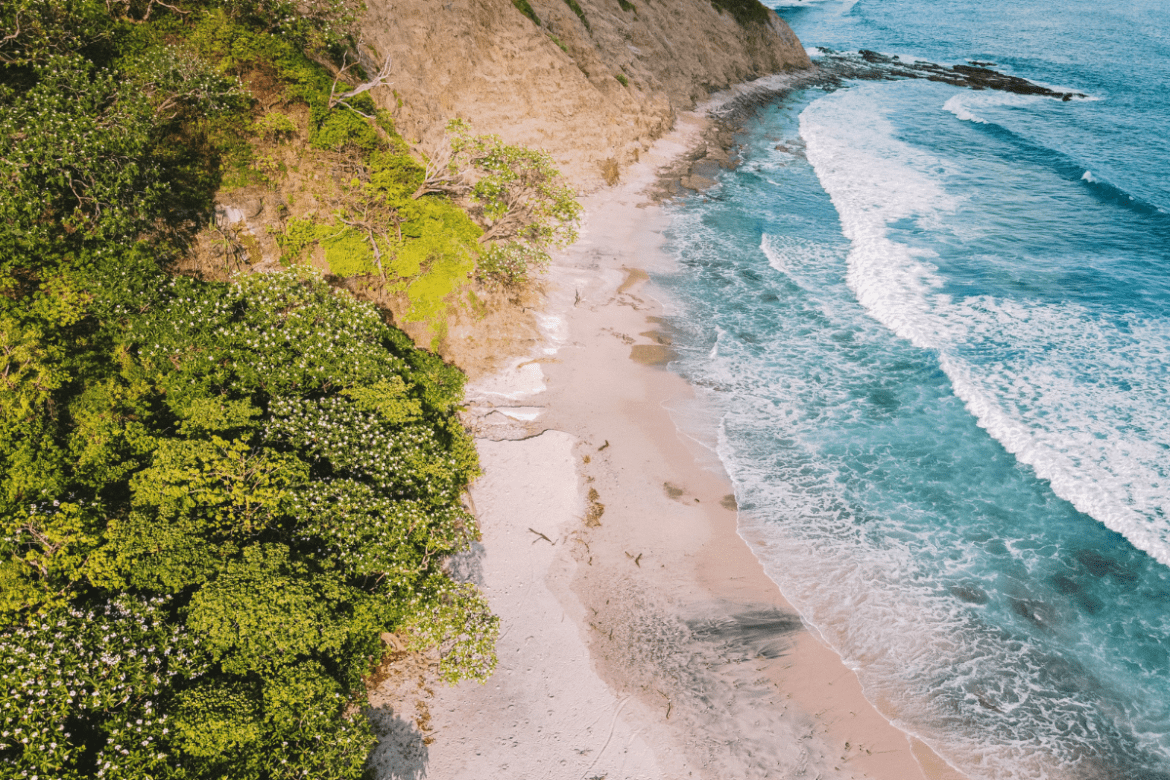The Nicoya Peninsula showed me a Costa Rica I didn’t know existed. Picture this: I’m sipping fresh coconut water on a completely empty beach, watching scarlet macaws soar overhead while howler monkeys create chaos in the jungle behind me. At Montezuma Beach, I saw my first wild sea turtle nesting under the stars, and I still get goosebumps thinking about it.
After exploring the best things to do in Nicoya Peninsula, I get why surfers and yogis have been keeping this place to themselves. From catching perfect waves at Santa Teresa (even as a total beginner) to swimming under waterfalls in Montezuma, this corner of Costa Rica feels like pure magic. Let me show you exactly why this peninsula stole my heart.
Must-See Attractions on the Nicoya Peninsula
Visiting the Nicoya Peninsula? Spend the day on Santa Teresa and Malpais Beaches, hike to the stunning Montezuma Waterfalls, or take a boat trip to Tortuga Island. Explore the diverse wildlife at Curu Wildlife Refuge, stroll through charming coastal towns for shopping and dining, or enjoy fresh seafood at a beachfront restaurant. Whether you’re into nature, adventure, or coastal relaxation, the Nicoya Peninsula has plenty to offer.
Before you book anything, don’t miss these deals 👇
- ✈️ Find cheap flights you won't see on Google – Going.com finds mistake fares and flash sales I use to save $200+ per ticket
- 🏨 Book your stay – Great deals on boutique hotels, apartments and vacation homes
- 🚗 Score cheap car rentals – Compare top companies in one spot
- 🎟️ Explore top-rated tours and activities – Skip the line and explore more

1. Santa Teresa and Malpais Beaches
If you’re chasing surf and sunsets, Santa Teresa and Malpais deliver in spades. These neighboring beach towns on the Nicoya Peninsula are famous for their consistent waves, relaxed energy, and golden coastlines. I stayed a few nights near Playa Carmen, and the rhythm of beach life was addictive—morning surf sessions, lazy brunches, and evenings spent watching locals play soccer in the sand. Even if you don’t surf, it’s easy to appreciate the scene.
Santa Teresa Beach is the more developed of the two, with yoga studios, beachfront cafés, and boutique hotels lining the main strip. Just down the road, Malpais has a more rugged, less commercial vibe, ideal for watching fishermen bring in their daily catch. Whether you’re up for an ATV tour or just want to relax with a cold drink in hand, this duo is a must-stop on your Nicoya adventure.

2. Montezuma Waterfalls
Tucked behind the coastal town of Montezuma, this series of waterfalls is one of the best nature escapes on the peninsula. The hike starts just outside town and winds through the jungle along a riverbed. It’s not a tough trail, but it can get muddy—definitely wear shoes with grip. The first waterfall is the tallest and most popular, with a deep pool at the bottom where people swim or jump from the surrounding rocks.
If you’re up for a bit more exploring, follow the trail to the upper falls. These are smaller but less crowded, and I found them to be a perfect place to cool off after the hike. Nearby, the town of Montezuma has a boho vibe with great vegetarian food, street art, and beachfront bars. Between the waterfalls and town, it’s easy to lose track of time here in the best way.

3. Tortuga Island
If you’re staying near Paquera or Montezuma, a day trip to Tortuga Island is a no-brainer. The boat ride alone is worth it—expect dolphins trailing the boat and occasional turtle sightings. Once you get to the island, you’re greeted with white sand, palm trees, and some of the clearest water on the Nicoya coast. I took a snorkeling tour here and swam above vibrant coral reefs packed with colorful fish.
Plenty of tour operators offer combo packages that include lunch on the beach, snorkeling gear, and even kayaking or banana boat rides. The vibes on the island are laid-back, with shaded picnic areas and a few local vendors selling fresh fruit or ceviche. It’s touristy, sure, but still beautiful and surprisingly peaceful if you find a quiet spot away from the boats. For a no-hassle island escape, Tortuga delivers.

4. Curu Wildlife Refuge
Curu Wildlife Refuge, located just north of Paquera, was one of the few places where I spotted capuchin monkeys up close in the wild. The network of well-maintained trails makes it easy to explore the refuge without needing a guide, though going with one definitely helps spot more animals. We saw deer, iguanas, and even a family of howler monkeys in the trees overhead.
What makes Curu special is its variety of habitats—dry forest, mangroves, and beach—all packed into one compact area. There’s even a beach inside the refuge where you can take a dip after hiking, and it’s usually not crowded. Early morning is the best time to go for both cooler temperatures and better wildlife viewing. Whether you’re into birdwatching, photography, or just walking in nature, this is one of the most rewarding and accessible reserves in the region.

5. Cabo Blanco Absolute Natural Reserve
At the southern tip of the peninsula, Cabo Blanco Absolute Natural Reserve is one of Costa Rica’s oldest protected areas. It’s not the easiest place to reach, but that’s part of the appeal—fewer people, more wildlife. The Sendero Sueco is a shorter forest trail, while the Sendero Cabo Blanco leads to a remote beach after a fairly rugged hike. We tackled the longer one and were rewarded with monkey sightings, scarlet macaws, and a nearly empty beach.
The reserve is dense with dry tropical forest, and the sounds of birds and howler monkeys echo through the trees. Rangers at the entrance provide trail maps and tips for spotting wildlife. Bring plenty of water—it gets hot, especially midday.
✈️ Pro Travel Tip:
I use Going.com to find crazy flight deals — think $300 roundtrip to Europe kind of crazy.
It’s free, and I honestly check it more than Google Flights. If you're booking travel, this is the first site I'd check. (Save 25% on Premium and Elite with my special code: JON25)
If you want to hike somewhere that feels truly wild yet protected, Cabo Blanco is a standout. It’s one of the quieter, more rewarding corners of the Nicoya Peninsula.

6. Playa Samara and Carrillo
Playa Samara is one of those places where it’s easy to settle in for a while. The beach has soft sand, calm waves, and a reef-protected bay that makes it safe for swimming and paddleboarding. I rented a board right on the beach and spent the afternoon cruising in warm, flat water. The town behind it is full of casual restaurants, surf schools, and juice bars.
Just a few minutes south, Playa Carrillo feels like a quieter alternative. It’s lined with palm trees, with almost no development right on the beach. If you’re looking for a peaceful spot to swim or watch the sunset, this is it. Locals bring coolers and hammocks for weekend hangouts.
The two beaches offer totally different vibes but are close enough to enjoy in a single day. Whether you’re into beach hopping or just want one spot to relax, this area delivers.

7. Nosara
Nosara has a bit of everything: surf, yoga, wellness, and wildlife. Playa Guiones is the main beach, and even if you’re new to surfing, this is a great place to learn. I booked a lesson here and was surprised how quickly I got up on the board. The waves are consistent, the beach is wide, and the vibe is welcoming for beginners.
Off the sand, Nosara has built a reputation as a yoga hub. There are several open-air studios like Bodhi Tree and Harmony Healing Center, offering classes with jungle views and salty breezes. Just north of town, the Ostional Wildlife Refuge hosts turtle nesting events—if your timing is right, it’s unforgettable.
Nosara also has some of the best dining options I’ve come across in Costa Rica. From smoothie bowls to gourmet seafood, it’s easy to fuel up after a day outdoors.

8. Playa Tambor
If you’re after a quieter slice of the Nicoya Peninsula, head to Playa Tambor. This wide, crescent-shaped bay has calm waves, soft sand, and a relaxed pace that’s perfect for families or anyone avoiding crowds. I stayed nearby for a few nights and found it to be one of the most laid-back beach towns on the coast.
The area around Tambor is more than just beachfront. You can take short hikes into the Tambor Hills, where wildlife sightings are common and the views over the bay are worth the climb. There’s also horseback riding along the sand and nearby fishing tours run by local operators.
The beach itself is rarely packed, and I often had long stretches all to myself. Tambor might not have the buzz of Santa Teresa or Nosara, but that’s exactly what makes it a gem for low-key travelers.

9. Barra Honda National Park
Barra Honda National Park is unlike most spots on the Nicoya Peninsula—it’s not about beaches, it’s about what lies underground. The park is famous for its limestone caves, and if you’re up for a bit of a challenge, you can climb down into Terciopelo Cave with a helmet and harness. I didn’t expect to be rappelling through a narrow hole into a cavern filled with stalactites, but it turned out to be one of the highlights of my trip.
Above ground, there are hiking trails with wildlife and scenic lookouts over the Gulf of Nicoya. We saw monkeys, birds, and even a coati on the way to one of the viewpoints. Not every cave is open to the public, but the ranger-guided tours are informative and safe. If you want a break from the beach and something a little more adventurous, Barra Honda is worth the detour.

10. Ostional Wildlife Refuge
If you’re visiting between July and December, don’t miss the Ostional Wildlife Refuge. This coastal sanctuary is one of the few places in the world where olive ridley sea turtles arrive by the thousands to lay their eggs during “arribadas.” I happened to be there during one of these events, and watching turtles cover the beach at night was unreal.
You’ll need a local guide to visit during nesting times, but that’s a good thing—they help protect the turtles and give you background on the conservation work here. Even outside the arribadas, Ostional is a peaceful spot for walking the beach or birdwatching.
It’s close to Nosara, so you can easily combine it with other activities. Whether you’re into wildlife or just want to witness something rare, this is one of the most meaningful experiences on the Nicoya Peninsula.

11. Tamarindo
Tamarindo is one of the more developed towns on the Nicoya Peninsula, and it’s a solid base if you like variety. It’s known for consistent surf, lively nightlife, and good food—all packed into one walkable beach town. I spent a few days here and found myself going from surf lessons at Playa Tamarindo in the morning to beachfront cocktails by sunset.
Beyond the beach, you’ve got options. There are estuary boat tours through Tamarindo Wildlife Refuge, where you can spot crocs, monkeys, and tons of birds. Inland, there are horseback rides and short hikes with views of the coast.
The town is touristy, but not in a bad way—it’s convenient and lively without losing too much of the local charm. If you’re new to Costa Rica or want a place that’s easy to settle into, Tamarindo makes a great starting point.

12. Mal País
Mal País is often lumped together with Santa Teresa, but it has its own flavor—quieter, more nature-focused, and full of adventure. What sets this place apart are the canopy tours through the jungle. I tried one on a whim and found myself ziplining above treetops, ocean in the distance, monkeys howling below.
It’s not just about adrenaline. Mal País is also a great spot for beach walks, surfing, and connecting with nature. You’re right next to the Cabo Blanco Reserve, so hiking and wildlife spotting are just minutes away.
The town itself is small, with rustic lodges, surf shops, and a few local restaurants. If you want to avoid the more crowded scenes but still want great beaches and adventure, Mal País is a perfect middle ground. It’s the kind of place where a quiet morning turns into a spontaneous zipline session before lunch.

Frequently Asked Questions about the Best Things to Do on Nicoya Peninsula
Looking for more content on the top things to do on the Nicoya Peninsula? Here are some popular questions (and answers) I get that will help you plan your trip to Nicoya Peninsula:
How do I get to the Nicoya Peninsula?
Reaching the Nicoya Peninsula is relatively straightforward. Most travelers fly into Liberia or San José. From Liberia, it’s a shorter drive to the peninsula. However, if you’re coming from San José, consider taking a ferry from Puntarenas to Paquera. This route offers breathtaking views and a unique travel experience. Whichever way you choose, the journey promises to be part of the adventure.
When’s the best time to visit the Nicoya Peninsula?
Costa Rica is one of the cheapest places to fly to. The ideal time to visit the Nicoya Peninsula is during the dry season, which runs from December to April. This period promises sunny days and vibrant nightlife. However, the green season, from May to November, has its charm. While you might encounter rain, the landscapes are lush, and there’s tranquility in the air. Plus, it’s less crowded, making it perfect for a serene getaway.
Is it safe to travel around the Nicoya Peninsula?
Generally, the Nicoya Peninsula is safe for tourists. However, as with any travel destination, it’s crucial to exercise caution. Avoid isolated areas, especially after dark, and always be aware of your surroundings. Secure your belongings and valuables. Engaging with locals can also provide insights into areas to explore and those to avoid.

What’s the main attraction of the Nicoya Peninsula?
The Nicoya Peninsula is a treasure trove of experiences. It’s renowned for its stunning beaches, perfect for sunbathing and surfing. Beyond the coast, you’ll find vibrant towns brimming with culture and history. The local cuisine is a treat, and the wildlife, especially in protected areas, is diverse. Whether you’re an adventurer or a relaxer, the peninsula caters to all.
Can I rent a car to explore the Nicoya Peninsula?
Yes, renting a car is a fantastic idea. It offers the freedom to explore hidden gems at your own pace. While the main roads are in good condition, be prepared for some rugged terrains as you venture off the beaten path. Always check local road conditions, especially during the rainy season, and ensure your vehicle is equipped for the journey.
Is Nicoya Costa Rica worth visiting?
Absolutely! Nicoya in Costa Rica is a gem waiting to be explored. It’s a blend of pristine beaches, lush rainforests, and vibrant local culture. The region offers a unique “Pura Vida” experience, away from the typical tourist traps. Whether you’re into surfing, hiking, or just relaxing by the beach, Nicoya promises a memorable getaway.
What is Nicoya Costa Rica famous for?
Nicoya is renowned for being part of the Blue Zones, areas where people live longer, healthier lives. Besides its longevity secrets, it’s famous for stunning beaches, rich biodiversity, and vibrant local traditions. The peninsula boasts archaeological sites, surf spots, and a unique blend of indigenous and colonial heritage, making it a diverse travel destination.
Concluding Thoughts on Exploring Nicoya Peninsula
Wrapping up a trip to the Nicoya Peninsula leaves you with more than just memories; it’s an experience that genuinely changes you. This isn’t your typical tourist destination. It’s a place where nature meets adventure, and where every turn introduces you to something unexpected.
From the laid-back beach towns to the dense jungles, Nicoya offers a slice of Costa Rica that’s raw and relatively untouched. If you’re looking to dive deep into Costa Rican culture, surf some epic waves, or just find a secluded spot to relax, this peninsula has got you covered. Don’t just take my word for it; pack those bags and see for yourself. The Nicoya Peninsula is waiting.

Need help planning your trip? Check out these helpful links:
- ✈️ Find cheap flights – I use this to snag deals you won't find elsewhere
- 🏨 Book accommodations – From boutique hotels to budget-friendly stays
- 🚗 Compare rental car prices – Great rates from trusted companies
- 🎟️ Discover affordable tours and day trips – Skip the line and explore more
- 📱 SIM Cards + eSims – My go-to phone plan I've used in 50+ countries




